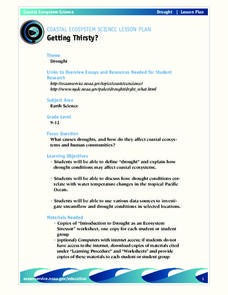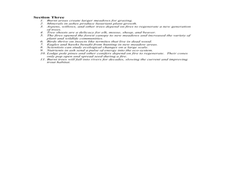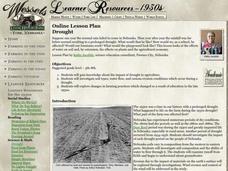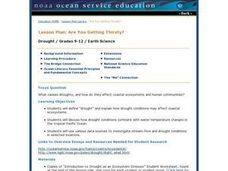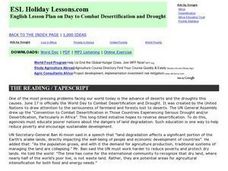Curated OER
Bringing Rain
Learners research folklore and scientific information about rain and water cycles. Then they communicate their understanding of water cycles by creating mobiles showing each stage. Students also write their own folk tales, explaining the...
Curated OER
Hopeful Eyes on Southern Skies
The Times covered a drought in 2011, which affected producers, consumers, and sellers. The class gets informed about climate and the economics of agriculture as the read this article and answer each of the 11 comprehension questions. A...
Curated OER
Science Jeopardy - The Earth Sciences
The earth sciences are the focus for this Jeopardy-style review game. Categories include geology, space, scientific investigation, meteorology, and oceanography. Diagrams and pictures are involved with most of the questions, making this...
Curated OER
What are Natural Disasters?
There are several types of natural disasters: quakes, floods, avalanches, and more. This slide show gives a brief explanation of each at an elementary-aged child's level. There are no frightening photos from actual natural disasters,...
Curated OER
Drought in Your State
In this drought activity, students study the "US Drought Monitor" and complete 8 short answer questions on the causes and effects of drought.
Curated OER
Getting Thirsty?
High schoolers explore the concept of drought and its significance as a natural hazard. In this drought lesson plan, students complete 13 questions on an "Introduction to Drought as an Ecosystem Stressor" worksheet and discuss the...
Curated OER
Drought Threatens Huge Man-Made Lake
Students locate Lake Mead, then read a news article about Lake Mead drying up and how that would effect water and power supplies to the region. In this current events lesson plan, the teacher introduces the article with a map and...
Curated OER
Dust Bowl Story
Students compose narratives describing the difficulties faced by those living in the Dust Bowl. They use resource sheets and photos in this small group activity. Their stories include plots, settings, and characters either taken...
Curated OER
Yellowstone fires: To Burn or Not to Burn
Students determine the causes of the 1988 Yellowstone fire. They list firefighting techniques, describe the aftermath, and list the ecological outcomes of the fire. They perform experiments with ignitable materials found in Yellowstone...
Curated OER
Drought
Students gain knowledge about the impact of drought in agriculture. They investigate soil types, water flow, and various erosion conditions which occur during a drought and see how farming practices changed after the 1930's.
Peace Corps
Weather and Water in Ghana
Students investigate the climate of their region. Students research statistics and conduct interviews. Students take a virtual tour of Ghana and discuss its climate. Students consider water conservation and the role it plays in both...
Curated OER
Thirsty for Drought Relief
Learners research a variety of drought-related concerns, acting as part of a 'drought preparedness taskforce.' They propose next steps for the government to take in case of drought and assess the viability of these proposals.
Curated OER
Are You Getting Thirsty?
Students study droughts and how they affect communities and coastal ecosystems. In this ecosystems lesson students use data to examine drought conditions in certain areas.
Curated OER
Drought Presentation
In this drought worksheet, students are given directions on how to give a presentation of facts, maps, videos, and more. Students inform the audience with 4 of the facts asked.
Curated OER
Day to Combat Desertification and Drought
In this day to combat desertification and drought learning exercise, learners read or listen to a passage, then match phrases, fill in the blanks, choose the correct words, unscramble words and sentences, write discussion questions and...
Curated OER
What is Weather?
In this weather worksheet, students photograph and record the weather conditions for a week. Then they list the types of clouds observed and the weather conditions they noted associated with each cloud type. Students also write a...
Curated OER
What is Drought?
Students explore and conduct an experiment on the effects of drought on the environment. They define what drought is and the impact that a shortage of rainfall can have on agriculture, municipal water supplies, tourism, recreation, etc.
Curated OER
Preparing for Drought
Students study droughts in Oklahoma and list possible reasons for droughts. They form subcommittees to explore the drought problem and create plans for drought management and relief. They research five areas around the world where...
Curated OER
LOSING GROUND
Students will observe wind erosion and how crop residue prevents erosion.Point out the three kinds of fields to the students. Do as much or as little instruction as needed to explain the pan with crop residue. Conservation tillage...
Curated OER
Defining Drought
Students examine the hydrologic impacts of drought. They look at drought from a variety of prespectives. Students first focus on the scientific definition of drought, including weather patterns, water cycles, water requirements by plants...
Curated OER
How Can We Conserve Water?
Students describe the importance of water conservation and list ways to conserve. They construct composts and fill them with materials that recycle nutrients. They inspect their homes for leaky pipes, toilets, and faucets.
Curated OER
Too Much...Or Not Enough?
Students discuss and define flooding. They identify areas in northeast Florida that may flood. Students examine droughts and explain the conditions that cause them. They examine the need for growth management in the state of Florida.
Curated OER
Current Events and Fish
Fifth graders examine current events impacting aquatic life in their communities. They search for newspaper, magazine and television reports for information about aquatic life in local bodies of water. Students can write letters to...
Curated OER
Cultural Lit. 26: Anasazi Pueblo: 1050 to 1300 A.D.
Sixth graders study Anasazi Culture through direct instruction and cooperative groups.







